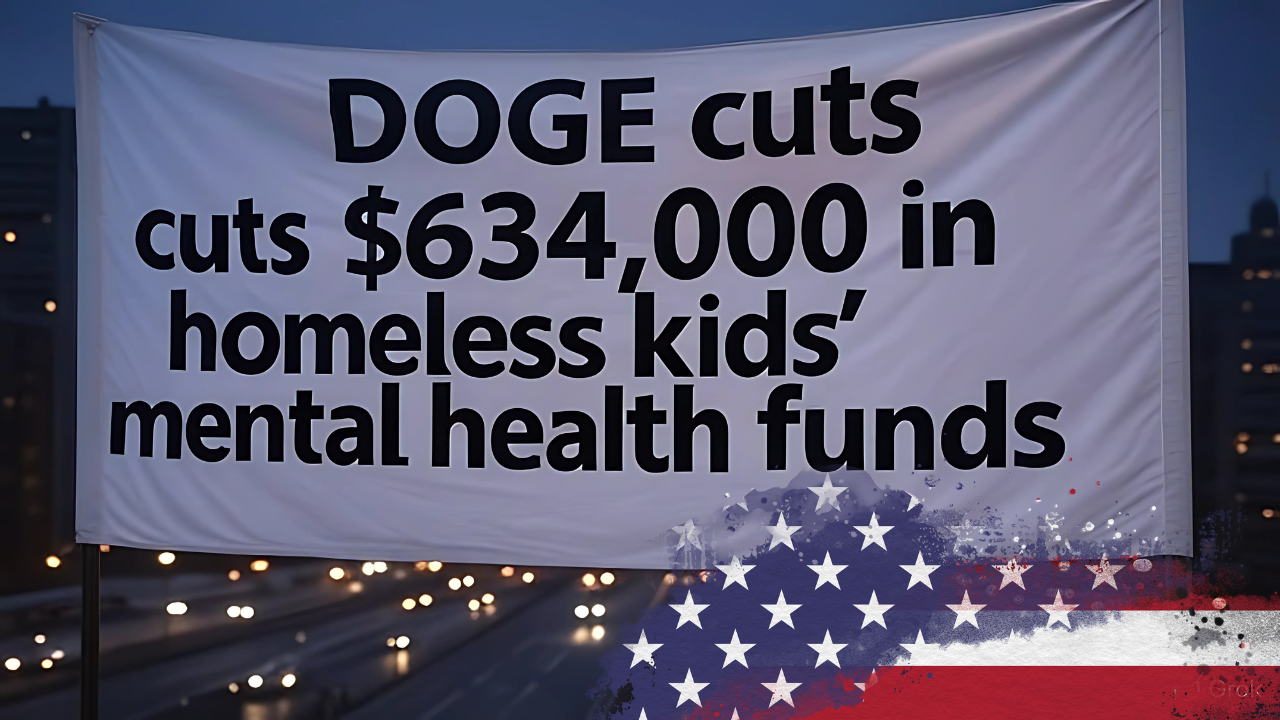In a move that has sent shockwaves through Nevada’s already fragile mental health support system, the Department of Government Efficiency (DOGE), led by Elon Musk, has terminated federal grants totaling $634,000. These funds were critical for providing mental health services to homeless children and youth in the state, particularly in rural areas like Elko and Humboldt Counties. The decision, announced in April 2025, has drawn sharp criticism from local officials, mental health advocates, and community leaders who warn of devastating consequences for vulnerable populations. As Nevada grapples with a long-standing mental health crisis, this abrupt cut threatens to deepen the struggles of homeless youth and exacerbate systemic gaps in care.
The Scope of the Funding Cuts
What Programs Were Affected?
The terminated grants directly supported several key initiatives aimed at addressing the mental health needs of Nevada’s youth, particularly those experiencing homelessness. One of the affected programs was the Nevada Rural Mental Health Outreach Program (RHOP), which provided free mental health counseling to children in Elko and Humboldt Counties—areas where access to such services is already scarce. RHOP, overseen by Dr. Dan Allen at the University of Nevada, Las Vegas (UNLV), offered telehealth services in school settings, partnering with the nonprofit Communities in Schools to reach students in need.
Another significant loss was a grant funded through the American Rescue Plan Act (ARPA), set to be administered by UNLV’s Education Department starting in September 2025. This grant was specifically designed to support the mental health needs of homeless youth through UNLV’s Partnership for Research, Assessment, Counseling, Therapy, and Innovative Clinical Education (PRACTICE). PRACTICE not only provided care to underserved populations but also trained future mental health professionals, addressing Nevada’s chronic shortage of providers.
Additionally, two other grants that supported rural youth mental health services were cut, impacting programs that offered specialized care for high-risk youth, including those with early signs of bipolar disorder or psychosis. The total loss across these three grants amounts to $634,000, a figure that may seem modest in the grand scheme of federal budgets but is monumental for communities already stretched thin.
Why Were the Cuts Made?
The decision to eliminate these grants came as part of DOGE’s broader mission to slash federal spending and streamline government operations. According to a letter from the Nevada Division of Public and Behavioral Health (DPBH), the state was informed that the grants were “no longer necessary” because they were tied to pandemic-era relief efforts. However, this rationale has been met with skepticism by critics who argue that the mental health needs of Nevada’s youth extend far beyond the pandemic.
Senator Catherine Cortez Masto, a vocal opponent of the cuts, wrote a letter to Health and Human Services Secretary Robert F. Kennedy Jr., demanding clarity on the decision. She emphasized that the funding was not solely for pandemic recovery but was instrumental in strengthening Nevada’s mental health infrastructure, particularly in rural and underserved areas. The lack of transparency from the Trump administration, which has yet to provide detailed explanations for the cuts, has only fueled frustration among stakeholders.
The Impact on Homeless Youth and Rural Communities
Immediate Effects on Mental Health Services
The termination of these grants has already begun to disrupt services for Nevada’s most vulnerable populations. In Elko and Humboldt Counties, telehealth programs that once served 150 students per semester have been scaled back significantly. Liz Carrasco, the clinical director of UNLV PRACTICE, reported that only 35 students received care this semester—a sharp decline attributed directly to the loss of funding. This reduction comes at a particularly critical time, as both counties are still reeling from teen suicides earlier in 2025.
For homeless youth, the cuts are even more dire. The ARPA-funded grant was intended to provide mental health support to a population that faces disproportionate rates of trauma, anxiety, depression, and substance abuse. Without this funding, many homeless children will lose access to counseling and other essential services, leaving them at greater risk of mental health crises. The timing of the cuts is especially troubling given Nevada’s long-standing struggle with youth suicide, which remains a leading cause of death for those aged 8-17 and 18-24.
Strain on Rural Communities
Rural areas like Elko and Humboldt Counties are particularly hard-hit by the funding cuts. These regions have historically lacked adequate mental health resources, with many residents facing long travel distances to access care. The RHOP telehealth program was a lifeline, allowing students to receive counseling directly in their schools. Morgan Pavao, a site coordinator for Communities in Schools in Northeastern Nevada, described the local mental health landscape as a “plague,” noting that stigma and limited access have contributed to annual suicides among her family and loved ones.
The loss of these programs not only reduces direct services but also impacts the training of future mental health professionals. UNLV PRACTICE relied on the grants to support post-graduate training, ensuring a pipeline of providers for rural areas. With the funding gone, these opportunities have been curtailed, further exacerbating Nevada’s shortage of mental health workers—a problem that predates the pandemic and continues to worsen.
Long-Term Consequences
The long-term effects of these cuts could be catastrophic for Nevada’s youth. Mental health experts warn that untreated mental health issues in childhood can lead to lifelong challenges, including chronic illness, substance abuse, and increased risk of homelessness in adulthood. For homeless youth, the lack of early intervention is particularly concerning, as they are already at higher risk for these outcomes.
Moreover, the cuts threaten to undo years of progress in building Nevada’s mental health infrastructure. The state has long ranked near the bottom in nationwide mental health care, and the pandemic-era funding had provided a much-needed boost to community-based services. Now, with those resources stripped away, Nevada risks falling even further behind, leaving its most vulnerable citizens without the support they need to thrive.
Reactions from Stakeholders
Outcry from Officials and Advocates
The decision to cut mental health funding has sparked widespread outrage among Nevada’s leaders and advocates. Senator Cortez Masto called the move “alarming” and a “direct threat to the mental health and well-being of Nevadans.” In her letter to Kennedy, she demanded answers about the rationale for the cuts, the potential impacts on affected programs, and what alternative funding sources might be available. Her concerns echo those of public health leaders who have long emphasized the importance of federal support in addressing Nevada’s mental health crisis.
Local officials and nonprofit leaders have also voiced their frustration. Dr. Dan Allen, director of the Nevada Rural Mental Health Outreach Program, expressed disappointment at the loss of funding, noting that the programs were crucial for delivering services to rural communities while training the next generation of providers. Morgan Pavao’s emotional testimony about the stigma and loss in her community underscores the human toll of these cuts, highlighting the urgent need for continued investment in mental health care.
Efforts to Mitigate the Damage
In the wake of the funding cuts, efforts are underway to find alternative sources of support. UNLV has provided short-term institutional funding to sustain services for a small portion of students, but these measures are set to expire in May 2025. Dr. Allen and his team are exploring other funding options, though the prospects remain uncertain given Nevada’s limited resources.
Some advocates are calling for state-level intervention to fill the gap left by the federal cuts. However, Nevada’s budget constraints and reliance on federal grants make this a challenging proposition. Senator Cortez Masto has pledged to continue pushing for answers and accountability from the Trump administration, hoping to restore the funding or secure alternative support for Nevada’s youth.
Broader Implications for Mental Health Policy
A Pattern of Disinvestment
The cuts in Nevada are part of a larger pattern of disinvestment in mental health under the Trump administration and DOGE’s leadership. Similar reductions have been reported in other states, with programs like the 988 mental health hotline and veteran housing initiatives facing funding uncertainties. The Department of Housing and Urban Development (HUD) has also seen significant staff cuts, raising concerns about the future of homelessness assistance programs nationwide.
This trend suggests a broader shift in federal priorities, with mental health and social services increasingly deprioritized in favor of other initiatives. Critics argue that this approach ignores the interconnectedness of mental health, housing, and economic stability, particularly for vulnerable populations like homeless youth. In Nevada, where mental health care has long been underfunded, these cuts could have a ripple effect, straining an already overburdened system.
The Need for a Holistic Approach
The DOGE cuts highlight the need for a more holistic approach to mental health policy. While reducing federal spending may align with certain ideological goals, it comes at the expense of programs that address the root causes of societal issues like homelessness and youth mental health crises. Advocates argue that investing in mental health is not only a moral imperative but also a cost-effective strategy, as early intervention can prevent more expensive outcomes like hospitalization, incarceration, or chronic homelessness.
Nevada’s experience also underscores the importance of federal-state collaboration. The state’s reliance on federal grants reflects a broader systemic issue: many states lack the resources to independently fund mental health programs, particularly in rural or underserved areas. A more equitable distribution of resources, coupled with sustained federal support, could help address these disparities and ensure that all children have access to the care they need.
Challenges and Opportunities
As Nevada navigates the fallout from the DOGE cuts, the path forward is fraught with challenges. The immediate priority is to secure alternative funding to sustain mental health services for homeless youth and rural communities. This may require a combination of state, local, and private investment, as well as advocacy to restore federal support.
There is also an opportunity for innovation in the face of adversity. Schools, nonprofits, and community organizations could explore new models of care, such as expanding telehealth services or partnering with local providers to fill gaps in access. Grassroots advocacy, led by affected communities, could also pressure policymakers to prioritize mental health funding in future budgets.
Ultimately, the DOGE cuts serve as a stark reminder of the fragility of mental health support in the U.S. They highlight the urgent need for a renewed commitment to addressing the needs of vulnerable populations, particularly homeless youth who are often overlooked in policy debates. As Nevada fights to recover from this setback, the voices of those most affected—children, families, and advocates—must guide the way forward.
FAQs
What programs were impacted by the DOGE cuts in Nevada?
The cuts affected the Nevada Rural Mental Health Outreach Program (RHOP), which provided telehealth counseling in Elko and Humboldt Counties, and an ARPA-funded grant for homeless youth mental health services through UNLV PRACTICE.
How much funding was cut?
The total funding cut across the three grants was $634,000, a significant loss for programs serving homeless and rural youth in Nevada.
Why were the grants terminated?
DOGE deemed the grants “no longer necessary” as they were tied to pandemic-era relief, though critics argue the mental health needs of youth extend beyond the pandemic.
What can be done to address the funding shortfall?
Efforts are underway to find alternative funding through state, local, or private sources, while advocates push for federal accountability and restoration of the grants.

